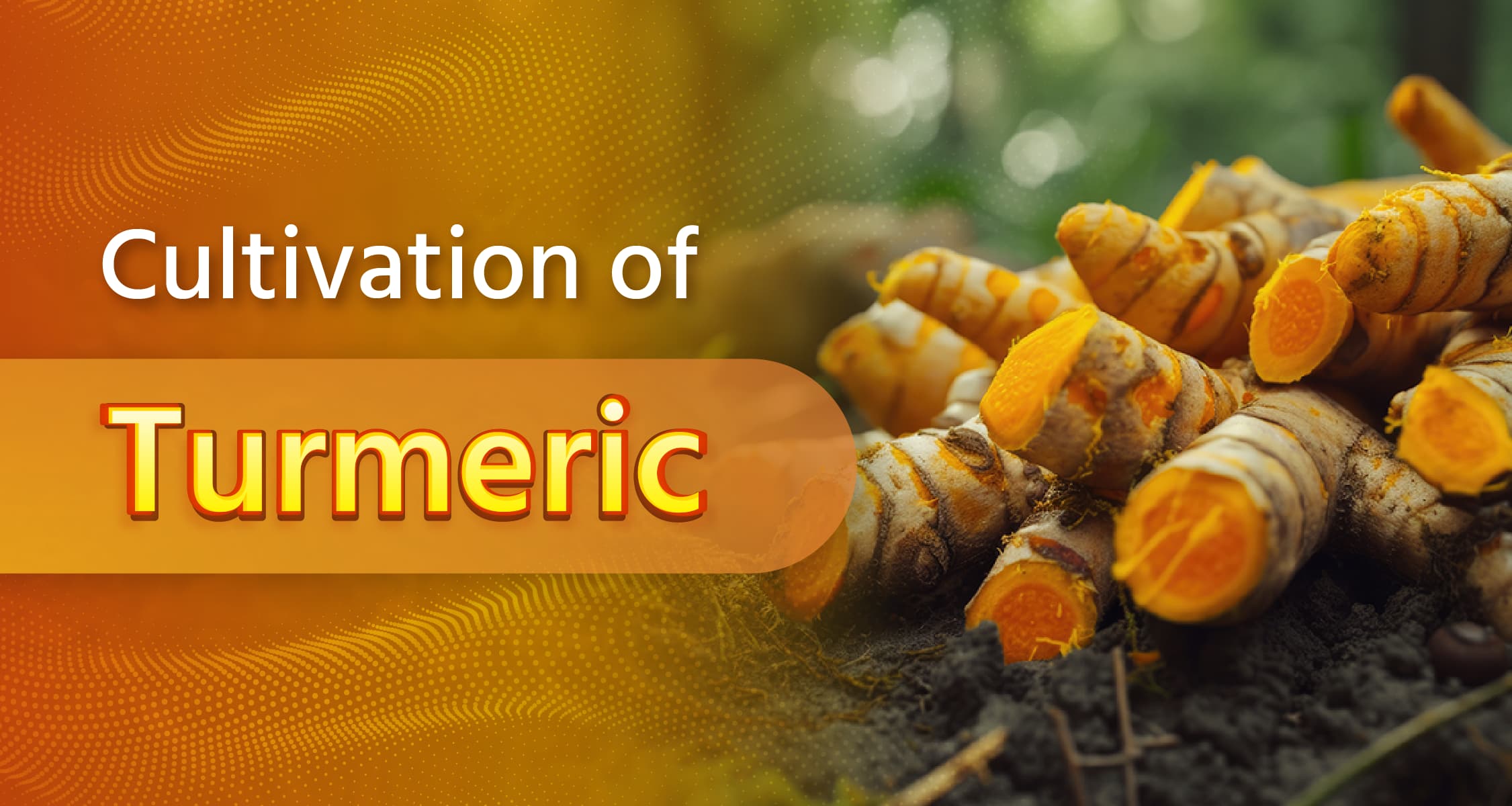Cultivation of Turmeric

Turmeric, an essential component of Indian spices, is also important for religious and social uses. The cultivation of turmeric is not only economically beneficial but also significant due to its medicinal properties, providing good earning opportunities. It offers benefits from both social and economic perspectives.
Efficient Cultivation of Turmeric
Climate: Turmeric grows well in tropical and subtropical climates. A temperature range of 20 to 35°C is considered suitable for better yield.
Soil: Turmeric can be cultivated in almost all types of soil, but red soil, clayey loam soil, and well-drained soil are the most suitable for optimal yield. The pH level of the soil should be between 4.5 to 7.5.
Sowing Time: The best time for turmeric cultivation is from June to July.
Varieties: Advanced varieties of turmeric include Rajapuri, Salem, Rajendra Sonia, Palam Pitamber, Sonia, Roma, Krishna, and Pant Pitambar, among others.
Seed Rate: 9 to 10 quintals of rhizomes are sufficient for one acre. Healthy rhizomes should be used for planting and should be treated before sowing.
Field Preparation: The field should be plowed a month before planting turmeric. After the first rainfall, plow the soil three to four times deeply to make it friable. Level the field using a roller and during the final plowing, apply well-decomposed cow dung manure.
Transplantation: Turmeric transplanting is done using the ridge and furrow method. For this, the distance between plants should be 25 cm and the distance between rows should be 40 to 60 cm. The length of the ridge should be 30 cm and the width should be 1 meter. The distance between the two ridges should be 50 cm.
Fertilizer Management: At the time of the final plowing of the field, thoroughly mix and use 120 to 150 quintals of decomposed cow dung manure, 50 kg of urea, 130 kg of DAP (Di-ammonium Phosphate), and 80 kg of MOP (Muriate of Potash) per acre. Additionally, use 4 kg of DeHaat Starter.
Irrigation: Turmeric plants do not require much irrigation in the initial stage. Water the plants at the time of transplanting in the summer and before the onset of the monsoon. Depending on the type of soil, irrigation can be done at intervals of 7-10 days. If irrigating by drip, do so at intervals of 1 to 2 days. Ensure proper drainage so that water does not stagnate in the field after irrigation. Stop irrigating the beds about a month before harvesting.
Weed Management: Regularly monitor the turmeric crop to control weeds and carry out thorough weeding 2 to 3 times. Use herbicides as needed. Alternatively, to prevent weed growth, spray Pendimethalin 3-4 days before sowing.
Pest and Disease Management
Pests
- Stem Borer Pest: The larvae of this pest create tunnels in the stems and penetrate the internal tissues. The affected central stem wilts and the presence of frass (insect waste) can be observed near the boring holes.
- Rhizome Borer Pest: This pest causes light brown circular holes on the rhizome coverings. By sucking sap from these holes, it causes dryness and shrinkage in the rhizomes, affecting germination.
- Thrips: Thrips have a harmful effect on leaves, causing them to curl, discolor, and gradually dry out. They attack during the monsoon season.
Diseases
- Leaf Spot Disease: Various-sized brown spots are found on the upper surface of new leaves, which can cover the entire leaf and eventually cause them to dry out.
- Leaf Blotch: Small, rectangular, oval, or irregular brown spots appear on both sides of the leaves, which later turn dark brown or dirty yellow.
- Leaf Blight: There are necrotic patches with paper-like white centers of various sizes on the leaf lamina, which later spread over the entire leaf, causing them to appear damaged.
Harvesting: When the leaves of the plants start turning yellow and dry up, the turmeric is ready for harvesting. Depending on the variety, turmeric matures and becomes ready for harvesting in 8 to 9 months. During the harvesting of turmeric, care should be taken that the tools do not damage the rhizomes.
Yield: The yield of raw turmeric is approximately 80-90 quintals per acre. After drying, it reduces to 20-25 quintals per acre.
How do you cultivate turmeric? Share your answers and experiences with us by commenting. If you liked this information, then follow the 'Krishi Gyan' channel now for more such content, and make sure to like it and share it with fellow farmers.
Frequently Asked Questions (FAQs)
Q: How often should turmeric crops be irrigated?
A: Turmeric crops should be irrigated 4-5 times during the summer. Regular irrigation helps maintain soil moisture, which is essential for the crop's growth.
Q: Why is weed management important in turmeric cultivation?
A: Weed management is important for turmeric crops because it increases productivity. Weeds compete with the crop for nutrients and water, which can affect the growth of the crop.
Q: What crops can be intercropped with turmeric?
A: Crops such as coconut, betel nut, chili, onion, brinjal, maize, and finger millet can be intercropped with turmeric. These crops are compatible with turmeric and beneficial in mixed farming.
Q: How much fertilizer is used for turmeric crops?
A: For one acre of land, 8 tons of cow dung manure, 8 quintals of neem cake, 60 kg of nitrogen, 35 kg of phosphorus, and 35 kg of potassium are used. This fertilizer balance provides the necessary nutrients for the crop.
Q: What is done after harvesting the turmeric crop?
A: After plowing the field, the turmeric rhizomes are carefully collected by hand and thoroughly cleaned. Then, the rhizomes are dried in the sun for 7-10 days. After drying, the outer skin is removed by threshing the rhizomes, and then they are stored.
जारी रखने के लिए कृपया लॉगिन करें

फसल चिकित्सक से मुफ़्त सलाह पाएँ
